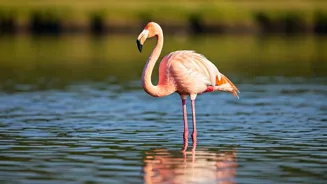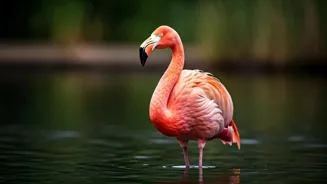Flamingo's Rosy Glow
Flamingos, renowned for their striking pink plumage, are a common sight in warmer regions globally. This coloration stems from their diet, which includes
carotenoid-rich algae and crustaceans. These pigments are ingested and deposited in their feathers, resulting in shades of pink ranging from pale to vivid. Their long legs and graceful necks, coupled with their pink hue, make them easily recognizable. Flamingos exhibit social behaviors, often gathering in large flocks. They are also masters of filtration feeding, using their specialized beaks to strain food from the water. The intensity of the pink can even indicate the bird's health and the quality of its diet. These fascinating birds provide a vibrant splash of color across their wetland habitats, highlighting the delicate balance of nature.
Pink River Dolphins
The Amazon River dolphin, or pink river dolphin, presents an unusual and engaging appearance. The color pink is not always visible, varying with the animal’s health, age, and activity level. Younger dolphins may have a greyish tinge, while mature males often display a vibrant pink. These dolphins inhabit the murky waters of the Amazon basin, navigating with echolocation and relying on unique sensory adaptations. Their pink hue could result from a combination of factors, including blood vessel visibility and the absence of melanin in their skin. These dolphins play a crucial role in the Amazon ecosystem, helping to regulate fish populations. As a threatened species, they face dangers from habitat loss and fishing activities, adding a layer of concern to their captivating beauty.
Rosy Boa's Elegance
The rosy boa, native to the arid regions of North America, is a snake that truly lives up to its name. While not always intensely pink, these boas often display shades of pink, red, orange, and brown on their scales. The specific hues and patterns vary from one snake to the next, making each one unique. Rosy boas are non-venomous constrictors, meaning they squeeze their prey to subdue it. They primarily feed on small mammals and are well-adapted to survive in harsh desert environments. Their coloration helps them blend into their surroundings, providing camouflage from predators and prey. They are a relatively docile species, making them popular among reptile enthusiasts. These snakes represent the quiet beauty that thrives in the dry landscapes of the American Southwest.
Axolotl's Pink Charm
Axolotls, fascinating amphibians from Mexico, are known for their remarkable regenerative abilities. While they can come in various colors, the pink morph is particularly enchanting. This pink coloration typically results from a genetic mutation that reduces melanin production. Their external gills, feather-like structures that protrude from the sides of their heads, add to their distinctive appearance. These creatures are popular in aquariums because of their friendly nature and unusual form. Axolotls also have the capability to regrow damaged body parts. Sadly, wild axolotl populations are critically endangered, highlighting the crucial need for conservation efforts. The pink axolotl, therefore, is not just a beautiful creature, but a symbol of resilience in the face of environmental challenges.
Pink Katydids' Camo
Pink katydids, although rare, offer a striking spectacle of nature. This unique coloration is the result of a genetic mutation called erythrism, which leads to an excess of red pigment. Normally, katydids are green, allowing them to blend seamlessly into their leafy habitats. The pink coloration, however, makes them easily visible, making them more vulnerable to predators. These insects, like their green counterparts, feed on plants and are known for their chirping sounds. They are an excellent example of how mutations can lead to unusual and eye-catching appearances. The rarity of pink katydids makes each sighting a special event, and offers a vivid reminder of the diversity present within the natural world.
Pink Cockatoo's Display
The pink cockatoo, or Major Mitchell's cockatoo, is native to Australia, and is recognizable by its pale pink plumage, highlighted by bright red and yellow on the crest. This vibrant parrot species often lives in pairs or small family groups and is known for its playful behavior. Their diet consists primarily of seeds, nuts, and fruits, which they forage in the dry interior of Australia. These birds have a distinctive call, helping them communicate with each other across the open landscapes. They also play a critical role in seed dispersal, aiding in the regeneration of native vegetation. Their pink coloration, combined with their crested heads and social nature, helps make the pink cockatoo a beloved symbol of the Australian outback.
Pink Starfish Wonders
Starfish, marine animals, can display a wide variety of colors, including a striking pink. The specific color depends on the species and the environment. Their bodies are covered with tiny structures called ossicles, which provide support and protection. Starfish are carnivorous, typically feeding on mollusks and other small organisms. They use their tube feet to move and to grasp their prey. These fascinating creatures are essential to their ecosystems, helping to control the populations of other marine life. Their unusual appearance and diverse forms make them a source of fascination for ocean lovers. Pink starfish, in particular, add an unexpected touch of beauty to the ocean floor.
Pink Sea Anemones
Sea anemones are marine animals, and various species showcase pink hues. They are closely related to jellyfish and corals. Sea anemones are typically found attached to rocks or the seafloor and are known for their stinging tentacles, which they use to capture prey. They have a simple body plan and come in diverse colors, with pink varieties adding a vibrant element to coral reefs and other marine habitats. The pink color of these creatures arises from pigments, which can vary based on their diet and the algae they harbor. These anemones contribute to the health and diversity of the marine environment and have a captivating appearance.
Pink Orchid Mantis
The orchid mantis is an insect species celebrated for its beautiful resemblance to a pink orchid flower. This striking appearance helps the mantis attract prey. The mantis uses its flower-like disguise to lie in wait for unsuspecting insects, often ambushing them with lightning-fast strikes. This camouflage allows it to both hunt and avoid predation. Its coloration varies from pink to white, with some displaying yellow markings. Orchid mantises are native to Southeast Asia and are an excellent example of evolutionary mimicry. This makes them very desirable to collectors. These mantises provide a fascinating glimpse into the intricate beauty and efficiency of nature.
Pink Land Snails
Some land snail species feature shells with pink hues. Their diet and habitat influence the color of their shells, which can range from light pink to more vibrant shades. Snails live in various environments, from forests to gardens, and play a vital role in the ecosystem by decomposing organic matter. The colors of the shells, besides pink, can also contain other colors or patterns. Some snails are popular in aquariums, while others are considered pests. The pink coloration adds another layer of fascination to these often overlooked creatures. These colorful snails highlight the surprising diversity that can be found, even in the most familiar environments.







